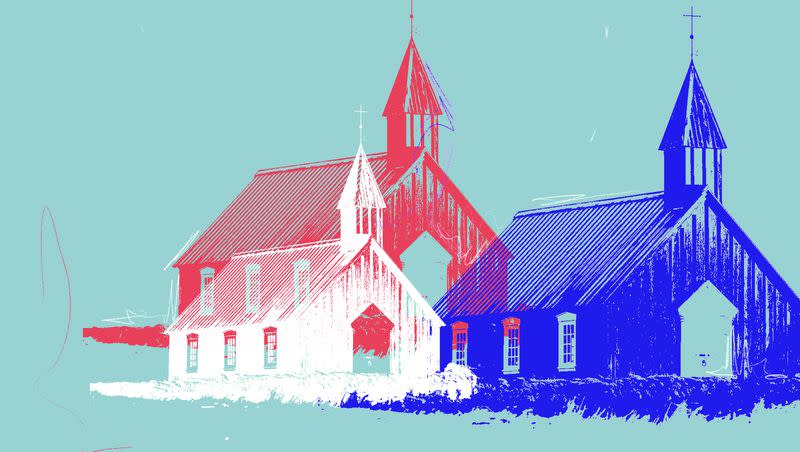The surprising share of Americans who don’t see political divisions at church

- Oops!Something went wrong.Please try again later.
This article was first published in the State of Faith newsletter. Sign up to receive the newsletter in your inbox each Monday night.
Editor’s Note: Kelsey is on maternity leave, but this newsletter isn’t. Before signing off, Kelsey prepped a few editions of State of Faith that will appear in your inbox about once per month throughout the summer.
The rise of former President Donald Trump brought with it a similar rise in stories about partisan tensions in the United States.
Reporters of all stripes, including me, have written hundreds, if not thousands, of articles in recent years about growing disdain between Republicans and Democrats and what it means for civic life.
Although I think those articles, for the most part, offered a fair and valuable assessment of a disturbing trend, I have to admit they didn’t tell the whole story. They rarely included insights from Americans who don’t think rising partisanship is a problem in their community — a group that apparently includes many Christian churchgoers.
Public Religion Research Institute’s Health of Congregations Survey, released in May, showed that just 13% of Christians who attend worship services at least a few times per year said their church is more divided by politics today than it was five years ago.
Most Christian churchgoers (56%) said that their church is not more divided, while 30% said they were unsure.
On a related note, large shares of churchgoers said their house of worship is doing somewhat well or very well discussing contentious political issues like racial justice (77%), anti-LGBTQ discrimination (65%) and abortion (71%).
Just 8% of Christian churchgoers said their congregation often or sometimes discusses Donald Trump.
These findings caught me off guard, which tells me I’ve been spending too much time reading news articles about church-related trends instead of speaking to actual churchgoers. I promise to do better in the lead-up to the 2024 election, which will almost certainly inspire a new wave of stories about partisan tensions.
Here are a few other interesting data points from Public Religion Research Institute’s report:
Sixteen percent of Americans say that religion is the most important thing in their life, while 36% say it’s one of many important things.
Members of The Church of Jesus Christ of Latter-day Saints are more likely than members of other faith groups to pray with others, attend non-worship-related church events or talk with religious leaders at least a few times per year. For example, 77% of Latter-day Saints said they pray with others at least a few times each year, compared to 71% of white evangelicals, 31% of white mainline Protestants and 32% of Jews.
People who attend religious services at least a few times per year are slightly more likely than the average American (23% vs. 20%) to have contacted a government official in the past 12 months.
Fresh off the press
AI will be used to translate the Bible. How does Biblical translation work?
Deseret News Editorial Board: The Supreme Court’s unanimous ruling restores religious liberty
The Supreme Court just ruled 9-0 for a religious worker. But his fight is not over
Supreme Court rules 6-3 in favor of web designer who won’t build same-sex wedding websites
Term of the month: Bethany Beyond the Jordan
Bethany Beyond the Jordan is a UNESCO World Heritage site along the eastern bank of the Jordan River. Christians believe it’s where Jesus was baptized, which is why thousands of religious pilgrims visit the area each year.
The site “features Roman and Byzantine remains including churches and chapels, a monastery, caves that have been used by hermits and pools in which baptisms were celebrated,” according to UNESCO’s website.
Last December, the government of Jordan announced a bold plan to makeover the area surrounding Bethany Beyond the Jordan to create a “tourist city,” as Reuters reported at the time. The project would “add souvenir shops and walking trails, boutique hotels and botanical gardens” in hopes of quintupling the amount of annual visitors.
Perhaps unsurprisingly, Jordan’s proposal was met with skepticism and, in some cases, outright rage. Some wonder if the potential economic benefits of the change would justify such intense disruptions to the natural landscape.
What I’m reading...
In 2016, I visited Rome and the Vatican to take part in a program for journalists covering the Catholic Church. One of the highlights of the trip was seeing the Vatican Museums, including the Sistine Chapel, and learning a bit about the Catholic Church’s longterm love affair with art. Happy memories from that experience flooded my mind as I read a fascinating story in The Atlantic about spending the night in the Vatican Museums.
Believe it or not, the 2024 presidential election is less than 18 months away, and religion and politics experts are already debating the role faith will play in the quickly approaching vote. In a recent column for Politico, scholar Ryan Burge argues that the nationwide rise in religious “nones” over the past decade will help the Democratic Party in many states, particularly in the Midwest, but not in all states, since there are some areas, like Florida and Texas, where religious participation is actually rising.
Odds and ends
What do names like Bonnie, Bella, Max and Hunter have in common? They’re popular names among both humans and dogs, according to The Washington Post.
Speaking of names, I really enjoyed author Connie Wang’s lovely column on why Connie is such a common name among Asian Americans. “I don’t think it’s a coincidence that all the Connies I spoke to describe their mothers in similar terms: as leaders, brave, athletic, creative, successful, idealistic, capable. These moms were architects, editors and medical professionals, who’d often had to abandon their careers and reinvent themselves upon moving to a new country, who looked at the television and saw how things might be different for their daughters,” she wrote.
